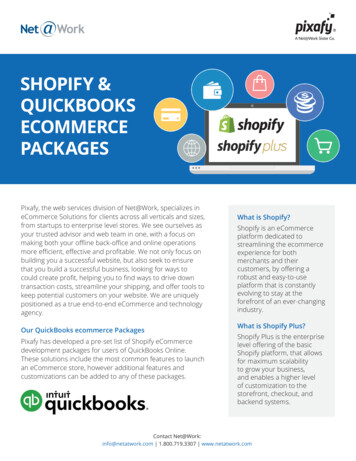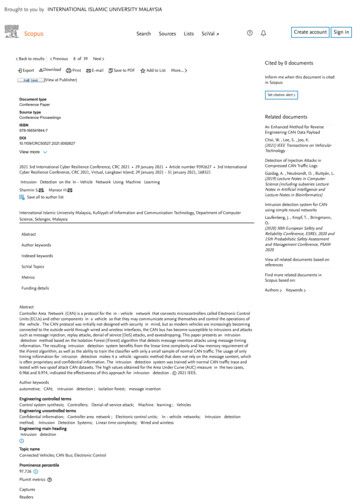
Transcription
ORGANIZATIONALSTRUCTUREbenchmarking data to help identify whatgood looks like for eCommerce teamsJune 21, 2018CRC eCOMMERCE COUNCILImportant disclosures can be found in Appendix
WHILE AMAZON HAS BEEN IN BUSINESS SINCE THE MID-90’S, THE RETAIL INDUSTRY IS ONLY IN THE FIRST INNING OF WHAT WILL BE ADRAMATIC CHANGE IN HOW TECHNOLOGY ENABLES CONSUMERS TO RESEARCH AND PURCHASE PRODUCTS. BRANDS THAT WILL BE RELEVANTJUST THREE YEARS FROM NOW WILL BE THE ONES THAT PUT ECOMMERCE AT THE CORE OF THEIR STRATEGY. WHILE THERE ARE A MILLIONDETAILS AND TACTICS TO CONSIDER IN SUCH A STRATEGY, AT THE CORE OF IT ALL RESIDES THE TEAM THAT IS RESPONSIBLE FORDEVELOPING AND EXECUTING AN ECOMMERCE STRATEGY THAT IS BOTH FAST GROWING AND PROFITABLE.TO HELP BRANDS DEVELOP THE RIGHT ECOMMERCE TEAM, WE INTERVIEWED LEADING SUPPLIERS, HOSTED ECOMMERCE ROUNDTABLES, ANDEXECUTED A BENCHMARK OF 140 COMPANIES. THE FOLLOWING REPORT LAYS OUT THE BEST PRACTICES WE DISCOVERED IN ADDITION TOGIVING BRANDS DIRECTIONAL GUIDANCE ON KEY ISSUES LIKE TEAM SIZE, REPORTING STRUCTURE, WHAT FUNCTIONS THEY OUTSOURCE,AND HOW TEAMS ARE WORKING TOGETHER.ALL DATA HAS LIMITATIONS AND ECOMMERCE TEAM RESEARCH IS PARTICULARLY VULNERABLE TO BROAD-SWEEPING CONCLUSIONS.HOWEVER, ECOMMERCE PROFESSIONALS CAN USE THE DATA IN THIS REPORT TO BUILD CONVICTION IN THEIR CURRENT ORGANIZATIONALSTRUCTURE AND FUTURE STRATEGIC PLANS OR OFFER SUPPORT FOR COURSE CORRECTING ONTO A BETTER PATH THAT WILL ENABLE THEORGANIZATION TO TAKE THE NEXT STEP TOWARDS A FASTER GROWING, MORE CONSUMER-RELEVANT FUTURE.IN ADDITION, WE RECOMMEND SHARING THIS REPORT WITH YOUR BOARD OF DIRECTORS, SENIOR LEADERSHIP, AND RETAIL AND DIGITALADVERTISING TEAMS TO HELP EDUCATE THEM ON BEST PRACTICES FOR INVESTING IN INTERNAL RESOURCES WHILE ALSO LEVERAGINGEXTERNAL COMPANIES TO HELP EXECUTE STRATEGIES THAT ARE CORE TO AN EFFECTIVE ECOMMERCE FOUNDATION.Source: 2018 eCommerce Team Benchmark, Cleveland Research Company2
KEY TAKEAWAYSeCOMMERCE LEADER IS A MUSTINVESTMENT IN DATA & CONTENT RESOURCESA majority of brands are structuring their teams with an experiencedeCommerce professional as a leader who provides expertise, is an evangelistof digital business strategies, has a vision for how eCommerce fits into theoverarching company strategy, and functions as a bridge for collaborationamong key teams. This year, 83% of companies report having an eCommerceleader in place – a dramatically higher rate than just a few years ntheirorganizations. These functions rose to the top in 2018 hiring plans, asmost brands are only scratching the surface on analytical insights andthere is growing momentum around the importance of eCommerceoptimized content.COMMUNICATION IS BESTUTILIZATION OF EXTERNAL RESOURCESOverall communication among omnichannel B&M and eCommerce accountmanagement and marketing teams needs more work according to our data.B&M account teams and the Amazon team continue to work in relative silosaccording to our data. On the positive side, teams managing AMS aremeeting more frequently with their digital advertising counterparts, which ishelping drive more optimal marketing investments.Too many brands try to do too much internally.Manual tasks likereview monitoring, MAP monitoring, unauthorized seller monitoring aretoo strained. We see an opportunity for brands to increase their usageof external parties to gain efficiencies and capabilities more quicklyand more robustly than what they can do on their own.eCOMMERCE AS CENTER OF EXCELLENCEUSE OF HYBRID AS A STRATEGIC TOOLA majority of brands are building out specific eCommerce teams in theirorganizations with resources pooled together to improve efficiencies andshare best practices. While many companies house individual omnichannelaccount leads outside the center of excellence (e.g. Walmart.com leadreports to Walmart lead), we are seeing much more of dotted line to theeCommerce organization in an effort to ensure dot.com is made a priority.The vast majority of brands are either doing the hybrid model orexploring the hybrid model based on our research. An effective hybridapproach requires resources though, and on average, companiespursuing this path are typically investing in 1-2 additional teammatesto help manage this business.Source: 2018 eCommerce Team Benchmark, Cleveland Research Company3
PATH TO PURCHASEOur 2017 consumer study indicates that the convenience factor with eCommerce is real for customers. An increasing number of shoppers are moving online for discover, product research, and purchasing.This number keeps growing each year. The following metrics show that it has never been more important to build out robust eCommerce strategies and to invest in eCommerce teams and leadership.BUYING ONLINEBUYING ON PHONESUSING PHONES IN STORES72% made at least 1-2purchases per month onlinein 2017 (vs. 70% in 2016)61% have purchasedusing their smartphone in2017 (vs. 58% in 2016)59% of shoppers use their mobiledevice at least sometimes when shoppingin store in 2017 (vs. 53% 2016)BUYING ON AMAZON86% purchased onAmazon in 2017(vs. 76% in 2016)Source: 2017 eCommerce Path to Purchase Consumer Survey, Cleveland Research CompanyAMAZON TRAFFIC65% visit Amazon most oftenwhen researching products in2017 (vs. 63% in 2016)LOOKING UP PRODUCTS63% use search engines mostoften when researching productsin 2017 (vs. 53% in 2016)4
83% 80%of brands have dedicatedeCommerce leaders*of brands have dedicatedeCommerce teams*Compared to prior years, both of these figures have increaseddramatically as brands have found that to keep up ecessity, which includes dedicated leadership and teams. Wesee a stark difference in companies that have brought on anexperienced eCommerce leader, as they tend to invest in theright programs and build a foundation for success.Source: 2018 eCommerce Team Benchmark, Cleveland Research Company*In some cases a brand may have a dedicated eCommerce leader without having a team in place. The eCommerce leader will typically utilize resources from other departments for eCommerce initiatives(i.e. Customer Service, Sales, Marketing, Operations, etc.)5
KEY TRAITS OF SUCCESFULeCOMMERCE LEADERSTHE VISIONARYTHE EVANGELISTTHE BRIDGETHE EXPERTDeveloping the eCommerce strategyacross accounts and within the contextof the company’s broader retailstrategy is critical. Visionaries can helpidentify changes coming to the industryand company more quickly and thusimprovestrategyandbusinessoutcomes.A successful eCommerce leader acts asthe key evangelist for eCommerceconsidering the inertia in someorganizations around evolving withmarket changes in retail. Beyondthinking about growing a bit faster witha successful eCommerce business, theevangelist can help articulate why thebrand needs eCommerce to stayrelevant three years from now and stayin business five years from now.The multifaceted nature of eCommercerequires teamwork and communicationacross the organization, including sales,marketing, product development andlogistics to name a few. TheeCommerce leader must be a true teamplayer that helps foster this type ofenvironment.We have seen a meaningful differencein performance in companies thatbrought in experienced eCommerceleaders compared to those companiesthat take a “learn as you go” approach.It is not enough to be well versed in agiven category; eCommerce experienceis essential for a firm to succeed online.6
AREAS eCOMMERCE FUNCTIONSREPORT INTO40%29%18%SALESLEADERSHIPMARKETING40% of brands house eCommerce teams under Salesas eCommerce impacts both the top and bottom linesfor organizations. Effectively managing retail accountsis a critical element of success.29% of brands house eCommerce teams under Leadership.This can be a particularly effective reporting structure asthis tends to drive leadership buy-in. Typically, eCommerceteams are able to get more investment for their strategicpriorities in this reporting structure.18% of brands house eCommerce teams under Marketing.This is primarily driven around the concept thateCommerce platforms like Amazon act very much likemarketing vehicles when we consider the path to purchasefor today’s shopper.When it comes to dot.com omnichannel teams, 56% of those teams report into their individual B&M retailer teams (e.g. Walmart.com team lead reports into broader Walmart team).This trend remains consistent in brands with large eCommerce share and those with eCommerce leaders in place.Source: 2018 eCommerce Team Benchmark, Cleveland Research Company7
TEAMS TEND TO HAVE CROSSFUNCTIONAL EXPERTISETeams are built as microcosms of the overall business structure, with cross-functional expertise covering everything from sales, to marketing, to logistics, toanalytics, and brand management. Most brands with dedicated eCommerce employees put the majority of resources into sales (88%) and contentmanagement (84%), as well as daily operations (80%) and analytics (75%). Employees who spend 50-90% of their time on eCommerce arepredominantly responsible for logistics (49%), content creation/management (40%), and daily operations (37%).E M P L O YE E S W I T H e C O M M E R C E R E S P O NS I B I L IT I E S100% of time50-90% of %21%67%40%48%28%37%49%25%40%*salescontent mgmtdaily operationscontent creationbrand mgmtlogisticsfinanceSource: 2018 eCommerce Team Benchmark, Cleveland Research Company* The percentage depicted in the chart shows the percentage of companies surveyed that have that specific function either dedicated 100% to eCommerce or spend 50%-90% of their time on eCommerce8
eCOMMERCERESPONSIBILITIES*BRANDS WITHeCOMMERCE LEADERSBRANDS WITHeCOMMERCE TEAMSBRANDS WITH LARGEeCOMMERCE SHARE**100% of time:sales, daily operations, contentmanagement, analytics, advertising.On average, there are about 12people on these teams (vs. 1-2 peoplein brands without eCommerceleadership).BRANDS WITHLARGE AMAZON BUSINESS***100% of time:sales, content management, dailyoperations, analytics, advertising. Onaverage, there are about 10 peopleon these teams (vs. 1-2 people inbrands without eCommerce teams).100% of time:sales, daily operations, contentmanagement, analytics, advertising.On average, there are close to 13people on these teams (vs. 6-7people in brands with loweCommerce share).100% of time:account management, dailyoperations, analytics, contentmanagement, AMS/AMG, contentcreation. On average there are 16-17people on these teams (vs. 5-6people in brands with low Amazonsales).50-90% of time:logistics, content creation, finance,daily operations. On average there are3-4 such employees (vs. 1-2 peoplein brands without eCommerceleadership).50-90% of time: logistics, finance,content creation, daily operations,analytics. On average, there areabout 4-5 such employees (vs. 2people in brands without eCommerceteams).50-90% of time: content creation,logistics, content management, dailyoperations, brand management. Onaverage, there are 6-7 suchemployees (vs. 2-3 people inbrands with low eCommerce share).50-90% of time:content creation and management,daily operations, logistics, analytics. Onaverage there are about 8 suchemployees (vs. about 2 people inbrands with low Amazon sales).Source: 2018 eCommerce Team Benchmark, Cleveland Research Company*eCommerce Responsibilities are listed in order from the largest to lowest percentage of brands reporting what roles team members are responsible for**Large eCommerce share is defined as 11% ( ) of annual revenue coming from eCommerce*** Large Amazon Business is defined as 40M ( ) of annual Amazon sales9
AMAZON TEAMS SPEND MOST OF THEIR TIMEON SALES FUNCTIONSIn companies with dedicated Amazon employees, responsibilities are most frequently allocated to sales (86%), daily operations (69%), analytics (60%) and AMS/AMGactivities (60%). On average there are 2-3 people on these Amazon teams. In companies with employees spending 50-90% on Amazon, most brands are allocatingresources into content management/creation (51%/42%), analytics (43%), and daily operations (42%). On average there are 2-3 such employees that are spendingbetween 50-90% of their time on Amazon.E M P L O YE E S W I T H A M A Z O N R E S P O NS I B I L I T I E S100% of time50-90% of time86%35%69%42%analytics60%43%AMS / AMG60%34%49%51%40%42%brand mgmt35%30%logistics35%30%18%22%sales*daily operationscontent mgmtcontent creationfinanceSource: 2018 eCommerce Team Benchmark, Cleveland Research Company* The percentage depicted in the chart shows the percentage of companies surveyed that have that specific function either dedicated 100% to Amazon or spend 50%-90% of their time on Amazon.10
AMAZONRESPONSIBILITIES*BRANDS WITHeCOMMERCE LEADERSBRANDS WITHeCOMMERCE TEAMSBRANDS WITH LARGEeCOMMERCE SHARE**BRANDS WITHLARGE AMAZON BUSINESS***100% of time:sales, daily operations, analytics,AMS/AMG. On average, there areclose to 3 people on these teams (vs.1 person in brands withouteCommerce leaders).100% of time:sales, daily operations, analytics,AMS/AMG, content management. Onaverage, there are about 3 peopleon these teams (vs. about 1 person inbrands without eCommerce teams)100% of time:sales, daily operations, AMS/AMG,analytics, content management. Onaverage, there are about 3 peopleon these teams (vs. 1-2 people inbrands with low eCommerce share).100% of time:sales, daily operations, AMS/AMG.Analytics, content management andcreation. On average there are close to5 people on these teams (vs. 1 personin brands with low Amazon sales).50-90% of time: contentmanagement, analytics, contentcreation, daily operations. Onaverage, there are 6 suchemployees (vs. 2 people in brandswith low eCommerce share).50-90% of time: contentmanagement, daily operations,content creation, sales, analytics. Onaverage there are about 7 suchemployees (vs. 1-2 people inbrands with low Amazon sales).50-90% of time: contentmanagement, analytics, dailyoperations, content creation, sales. Onaverage there are about 3 suchemployees (vs. 1-2 people in brandswithout eCommerce leaders).50-90% of time: contentmanagement, analytics, contentcreation, daily operations, AMS/AMG.On average, there are 3-4 suchemployees (vs. about 1 person inbrands without eCommerce teams).Source: 2018 eCommerce Team Benchmark, Cleveland Research Company*Amazon Responsibilities are listed in order from the largest to lowest percentage of brands reporting what roles team members are responsible for**Large eCommerce share is defined as 11% ( ) of annual revenue coming from eCommerce*** Large Amazon Business is defined as 40M ( ) of annual Amazon sales11
eCOMMERCE-SPECIFIC EMPLOYEESARE ON THE RISEOn average, companies are dedicating more employees to eCommerce-specific activities ( 55% vs. 2017), while the number of employees spending at least 50% of theirtime on eCommerce activities has gone down (-13% vs. 2017). This year, brands are employing around 10 full time and 4 part time employees for eCommerce. Brands employ2-3 people specifically for full time ( 23% vs. 2017) as well as part time for Amazon ( 10% vs. 2017). When it comes to planning for the future, companies are expectingto hire approximately the same number of employees for eCommerce and Amazon in 2018 as last year.SIZE OF eCOMMERCE AND AMAZON TEAMS2017 2018How many employees do you have dedicated toeCommerce (90% of time)?6.9How many employees are not dedicated to eCommerce but spend more than50% of their time on eCommerce-related responsibilities?10.74.74.1How many employees do you plan to hire over the next 12 months specificallydedicated to eCommerce?2.2How many employees do you currently havededicated to Amazon?How many employees are not dedicated to Amazon but spend more than 50%of their time on Amazon-related responsibilities?2.12.62.6How many employees do you plan to hire over the next 12 months specificallydedicated to Amazon?Source: 2018 eCommerce Team Benchmark, Cleveland Research Company2.02.90.8 0.712
ORGANIZATIONS ARE EMPHASINGDEDICATED STAFF FOR eCOMMERCE TEAMSNot surprisingly, the larger the eCommerce business, the more full time and part time staff are needed. The chart below illustrates the gradual increase in team size that occurs ascompanies grow their sales from 5mm to over 100mm. Regardless of large or small eCommerce business, companies have prioritized more human capital dedicated to eCommercecompared to employees that spend of portion of their time on eCommerce.How many employees at your organization are dedicated toeCommerce, and how many spend 50-90% on eCommerce?Employees spending100% on eCommerceEmployees spending50-90% on eCommerce14.09.16.85.33.72.04.43.91.81.5Less than 5M 5M - 20M 20.1M - 60M 60.1M - 100MGreater than 100.1MTotal eCommerce RevenueSource: 2018 eCommerce Team Benchmark, Cleveland Research Company13
AMAZON TEAMS ARE COMPRISED OF BOTHDEDICATED & PART TIME SUPPORTSimilar to eCommerce as a whole, on average, the larger the size of ones Amazon business, the larger the team. When it comes to Amazon, there is more of an even split betweenemployees dedicated to the account and those that spend a portion of their time on the account. Within the data, the brands with the largest eCommerce revenue are have 3-4dedicated staff on the account, although more variation exists.How many employees at your organization are dedicated to Amazon,and how many spend 50-90% on Amazon?Employees spending100% on AmazonEmployees spending50-90% on Amazon52 12222-31Less than 5M 5M - 20M 20.1M - 60M 60.1M - 100MTotal Amazon RevenueSource: 2018 eCommerce Team Benchmark, Cleveland Research Company14
ECOMMERCE TEAM GROWTHEXPECTED IN ’18Overall, large brands are more likely to plan to hire dedicated eCommerce employees over the next 12 months as opposed to smaller brands. As for Amazon, both small and largebrands are planning to make small additions to their teams over the next year. Interestingly, brands in the 150M- 250M bucket are not planning to hire any part time Amazonsupport. This is likely due to the fact that brands in this category already have a sizeable Amazon team as well as eCommerce staff (pg. 13-14).How many employees to do you plan to hire for eCommerce andAmazon over the next 12 months?Planning to hire foreCommerce in the next yearPlanning to hire for Amazon inthe next year2-3212-3 1 11 1 1Less than 5M 1 5M - 20M 20.1M - 60M 60.1M - 100MGreater than 100.1MTotal eCommerce RevenueSource: 2018 eCommerce Team Benchmark, Cleveland Research Company15
TEAMS BY CATEGORYFOOD &CONSUMABLESHEALTH &BEAUTYHOMEIMPROVEMENTOTHERCATEGORIESeCommerce: Food & Consumablesbrands typically have about 9 peoplededicated to eCommerce, and about 2people who spend 50-90% of theirtime on eCommerce.eCommerce: Health & Beautybrands typically have 6 peoplededicated to eCommerce, and about 3people who spend 50-90% of theirtime on eCommerce.eCommerce: Home Improvementbrands typically have 4-5 peoplededicated to eCommerce, and about 23 people who spend 50-90% of theirtime on eCommerce.eCommerce: Brands in the othercategories combined typically haveabout 6 people dedicated toeCommerce, and 5 people who spend50-90% of their time on eCommerce.Amazon: These brands typically have1-2 employees dedicated to Amazon,and about 2 employees spending 5090% of their time on Amazon.Amazon: These brands have 1-2employees dedicated to Amazon, andabout 1-2 employees spending 5090% of their time on Amazon.Amazon: These brands have 1employee dedicated to Amazon, andabout 1-2 employees spending 5090% of their time on Amazon.Amazon: These brands have 1-2employees dedicated to Amazon, andabout 2-3 employees spending 50-90%of their time on Amazon.Future Plans: In the next 12 monthsthese brands are planning to hire 1-2additional employees for eCommerce,and 1 employee for Amazon.Future Plans: In the next 12 monthsthese brands are planning to hireabout 3 additional employees foreCommerce, and 1-2 employees forAmazon.Future Plans: In the next 12 monthsthese brands are planning to hire 1-2additional employees for eCommerce,and 1 employee for Amazon.Future Plans: In the next 12 monthsthese brands are planning to hire 4-5additional employees for eCommerce,and 1 employee for Amazon.Source: 2018 eCommerce Team Benchmark, Cleveland Research Company16
THE IMPORTANCE OF CONTENT ONLINE CANNOT BE OVERSTATED. OUR RESEARCH SHOWS THAT CUSTOMERS USE BRANDWEBSITES, AMAZON, AS WELL AS SOCIAL MEDIA WHEN RESEARCHING PRODUCTS. IN 2017 83% OF SHOPPERS AT ,WITH 23%LOOKINGFORPRODUCTINFORMATIONSPECIFICALLY. THUS, IT IS IMPERATIVE THAT BRANDS DEDICATE RESOURCES TO CREATING, MANAGING, SYNDICATING,AND OPTIMIZING CONTENT.Source: 2018 eCommerce Team Benchmark, Cleveland Research Company17
CONTENT CREATION IS HOUSED INTERNALLYBefore any marketing and advertising initiatives take place, it is important to optimize content. Internally, brand teams, creative marketing, and eCommerce / Amazonteams are responsible for content creation. In firms with larger eCommerce share of business (11% of total sales), creative marketing teams and eCommerce / Amazonteams tend to own content creation. In firms with smaller eCommerce share (10%- of total sales), marketing, eCommerce, and brand teams tend own content creation.It is also common for internal and external teams to collaborate on content creation.TE AMS THAT AR E INVOLVE D IN C ONTE NTC R E ATIONBrands site teams that are most commonly involved in content creation. For instance,48% of brands report marketing teams being involved either owning it entirely orworking with other departments.MOST C OMMON C OLLAB OR ATIONS OF TE AMSON C ONTE NT C R E ATIONBrands site a collaboration of two to three teams as most common. For instance, for 16% ofbrands, creative marketing, eCommerce, and external partners collaborate on contentcreation.16%48%15%26%8%16%Marketing TeamMarketingTeameCommerce TeamEcommerceTeamExternal PartnerExternalPartner4%6%Product DevelopmentSource: 2018 eCommerce Team Benchmark, Cleveland Research CompanyProductDevelopmentCreative Marketing , Creative marketing, eComCreativeMarketing,Creative Marketing,eCom, externaleCom, ExternaleComCreative marketing,Creative rnalproductdevelopment,Product Development,ExternaleComeCom18
82%of shoppers report beginning their product research online. Customers aregoing to Amazon, search engines, and brand websites for product information .Optimizing content has never been more important. Many brands hire externalexpertise to create and optimize content for maximum impact to the bottom line.EXTERNAL RESOURCES FORCONTENT RELATED FUNCTIONS28%CREATION28% of brands use externalresources for contentcreation.35%PIM/DAM35% of brands use externalresources for Product Information(PIM) and Data AttributeManagement (DAM) systems.Source: 2018 eCommerce Team Benchmark, Cleveland Research Company30%28%30%SYNDICATIONAUDITINGOPTIMIZATION30% of brands use externalresources for contentsyndication.28% of brands use externalresources for contentauditing.30% of brands use externalresources for contentoptimization.19
WITH RESOURCES BEING HEAVILY ALLOCATED TO SALES, DAILY OPERATIONS, AND ADVERTISING CURRENTLY, THEMAJORITY OF BRANDS ARE LOOKING TO BEEF UP THESE AREAS EVEN FURTHER IN THE NEXT 12 MONTHS. BRANDS AREALSO LOOKING TO HIRE ANALYTICS ROLES TO CAPITALIZE ON THE VAST AMOUNT OF DATA THAT IS AVAILABLE.Source: 2018 eCommerce Team Benchmark, Cleveland Research Company20
BRANDS ARE LOOKINGTO LEVERAGE DATAeCommerce roles brands are planning to hire overthe next 12 t34%dailyops27%contentcreation23%On average, brands are continuing to hire heavily into sales and contentcapabilities. However, a large portion of brands are now prioritizinganalytics (47%), realizing that data can be leveraged to optimize variousbusiness and sales initiatives.Both brands with dedicated eCommerce leaders (49%) and teams (47%)are prioritizing analytics at rates similar to the overall average for brands.On the other hand, brands without dedicated eCommerce leaders (70%)and teams (56%) are prioritizing content management well aboveaverage.logisticsmgmt19%Analytics is equally as important to brands with large (51%) and low(38%) eCommerce share. However, brands with low eCommerce shareare also focused on content creation (38%) and content management(38%). Large eCommerce share is defined as 11% .ads creative19%Similarly, analytics is a priority for brands with small (44%) and large(62%) Amazon business. Large Amazon business is defined as 40M .brandmgmt18%Source: 2018 eCommerce Team Benchmark, Cleveland Research Company* Percentages shown are the percent of respondents that cited they plan on hiring that function in 2018.21
AMAZON ROLES FOCUSED ON SALES DATAWhen it comes to Amazon teams, on average, brands are planning to expand sales capabilities along with analytics in the next 12 months.Both brands with dedicated eCommerce leaders and teams are prioritizing analytics and sales for Amazon. 49% of brands with eCommerce leaders and 50% of brands with eCommerceteams are hiring analytics roles for Amazon, while 47% of brands with eCommerce leadership and 48% of brands with eCommerce teams are hiring staff into Amazon sales roles. Sales islikely taking a backseat to analytics in many cases because these organizations already have robust sales teams, as 85% of brands with eCommerce leaders and 88% of brands witheCommerce teams report having dedicated sales staff. When it comes to brands without eCommerce leaders or teams, sales takes first priority. 100% of brands without eCommerceleaders and 70% of brands without eCommerce teams are planning to hire sales roles for Amazon in 2018.Analytics is a priority for brands with large eCommerce share (11% ) and large Amazon business ( 40M ): 50% of these brands report planning to hire analytics roles. The focus onanalytics over sales in brands with large eCommerce share is primarily due to these brands already having strong sales functions, as 89% report dedicated Amazon sales roles. Similarly,focus on analytics takes precedence over sales in brands with large Amazon business, being driven by the fact that 91% report dedicated Amazon sales employees. On the other hand,brands with lower eCommerce share and Amazon business are focusing on sales this year. 50% of brands with eCommerce share that is 10% and below, and 64% brands with Amazonsales below 40M, are looking to hire into sales.51%Amazon roles brands are planning to hireover the next 12 t28%dailyopsSource: 2018 eCommerce Team Benchmark, Cleveland Research Company* Percentages shown are the percent of respondents that cited they plan on hiring that function for Amazon in 2018.28%contentcreation26%AMS AMG19%brandmgmt19%logisticsmgmt22
BRANDS PLAN TO KEEP INVESTINGIN AMAZONBrands continue to see Amazon as a growth channel, and it continues (for the third straight year) to be the channel brands are focusing on the most with newresources. Walmart.com comes in second in terms of resource allocation, and brand’s own websites come in third.The trend of resource allocation to these channels remains constant when we look at brands with large Amazon business and those with large portions of theirsales coming from eCommerce. Many of these brands are also investing into Jet which is somewhat surprising as Walmart has pulled back to a degree on thatbusiness.Retailers brands plan to invest in:Amazon.comAMAZON67%W A L M A RWalmart.comT.COM30%B R A N D DirectW EtoB ConsumerSITE28%Jet.comJET20%T A R G E TTarget.com.COM13%H O M E D E PHomeDepot.comOT.COM12%Source: 2018 eCommerce Team Benchmark, Cleveland Research Company23
HOW OFTEN DOES YOUR AMAZON TEAMMEET WITH ITS B&M COLLEAGUES?In general, communication between Amazon teams and B&M omnichannel teams is slightly worse than last year, with 65% of teams meeting at leastquarterly (-3 points vs. 2017). The percentage of brands reporting to “never” communicate increased 3 points since last year. This remains a major opportunity forcompanies looking to better coordinate their strategy across in-store and dot.com, in addition to best practice sharing from Amazon that can be applied to omnichannelretail customers.2017ONCE PERWEEKONCE PERMONTHONCE PERQUARTER201814%13%23%23%27%32%ONCE PERYEARNEVERSource: 2018 eCommerce Team Benchmark, Cleveland Research Company13%9%8%16%24
59%WHO UTILIZES SVS?AVERAGE PERCENTAGE OF BRANDSUTILIZING AMAZON STRATEGICVENDOR SERVICES (SVS)Amazon is a key area of investment for brands. In additionto building out internal Amazon teams, more brands areinvesting in SVS (Strategic Vendor Services), particularlythose with robust Amazon sales growth.01. BRANDS WITHeCOMMERCELEADERS02. BRANDS WITHeCOMMERCETEAMS03. BRANDS WITHLARGE eCOMMERCESHARE*04. BRANDS WITHLARGE AMAZONBUSINESS**46% of brands with eCommerceleadership at a mid to senior levelutilize SVS. These brands also tend tohave dedicated eCommerce teams.45% of brands with dedicatedeCommerce teams utilize SVS. Thesebrands typically have an eCommerceleader at the mid to senior level.59% of brands with large eCommerceshare are utilizing SVS. These brands arelikely to have a dedicated eCommerceteam, but less likely to have a dedicatedeCommerce leader.74% of brands with large Amazonbusiness are utilizing SVS. Thesebrands tend to have an eCommerceteam as well as an eCommerce leaderat a mid to senior level.Source: 2018 eCommerce Team Benchmark, Cleveland Research Company* Large eCommerce share is defined as 11% ( ) of annual revenue coming from eCommerce** Large Amazon Business is defined as 40M ( ) of annual Amazon sales25
SVS USE BY BROKEN DOWN BYCATEGORY AMAZON REVENUE60% OF HEALTH &BEAUTY BRANDSutilize SVS46% OF HOMEI
all data has limitations and ecommerce team research is particularly vulnerable to broad-sweeping conclusions. however, ecommerce professionals can use the data in this report to build conviction in their current organizational structure and future strategic plans or offer support for course correcting onto a better path that will enable the










